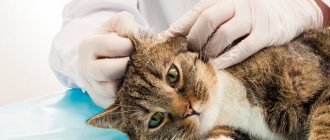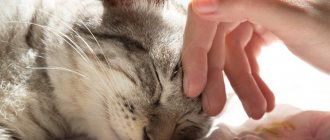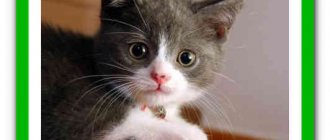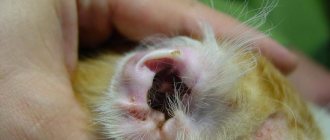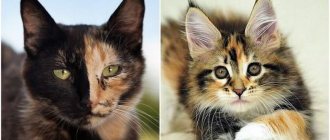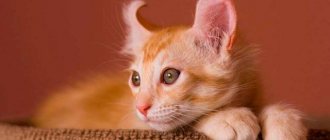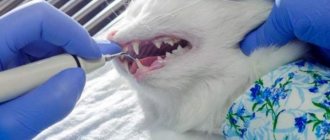Dehydration in a cat can occur due to prolonged diarrhea or prolonged vomiting caused by various diseases. Due to the lack of fluid in the cat's body, the mucous membranes dry out, the animal's nose also becomes dry, the cat is lethargic and experiences constant thirst. Veterinarians warn that if signs of dehydration are not eliminated in time, dangerous complications may appear or the small kitten will die.
Causes
Most often, lack of water in cats is caused by eating disorders - vomiting and diarrhea, resulting from intoxication caused by:
- bacterial or viral infection, as well as the presence of parasites in the digestive tract;
- intestinal obstruction;
- diseases of the liver and pancreas;
- tumors in the gastrointestinal tract;
- consumption of stale and poisoned food;
Dehydration may be caused by a bacterial or viral infection
Other causes of dehydration include:
- a small amount of water to drink, especially when the animal consumes dry food;
- food allergies, moreover, it can be both to natural products and to store-bought formulations for cats;
- individual reaction of the body to certain veterinary drugs;
- excessive blood loss after injuries;
- recent surgical operations, as well as painful diagnostic procedures;
- stress, including from a long journey in a closed “carrying”;
- high body temperature due to pathologies or overheating of the animal;
- refusal to drink, which most often happens due to nausea, and also because the water in the bowl is stale;
- polyuria (excessive urine production) caused by various pathologies;
- diseases of endocrine organs.
The cat must have constant access to clean water
On a note! There are often cases when a cat suffers from a persistent lack of moisture in the body just because the owner has placed a bowl of water in an inconvenient place. The animal's access to drink should be easy and free.
How much water should a cat drink per day?
Cats drink as much as they need. According to statistics, the daily norm should be from 20 to 40 mg per 1 kg of body. If your cat weighs 5 kg, she should drink up to 100 ml of liquid per day. Pregnant and breastfeeding women should drink twice as much. Breastfed kittens do not need water at all. They receive their daily fluid intake from their mother's milk.
A cat's body is made up of 70% liquid.
The given amount should not be considered as something that a pet must necessarily drink daily. Consumption depends on the following points:
- age, weight and breed of the cat;
- time of year and room temperature;
- type of feed;
- convenience of drinking bowl.
If the cat is on dry food, liquid intake should be two or three times the amount eaten. For example, if an animal eats 50 g of food, then it should drink from 140 to 180 g of water, depending on its weight. Canned food contains about 80% liquid. To quench your thirst, 100 g of water will be enough for your cat.
Important! Even if the kitten has eaten soup or drank kefir, clean water must be present, otherwise it will not receive the necessary minerals.
Increased thirst over several days is a reason to consult a veterinarian
Stages and signs of dehydration
There are three forms of dehydration, each of which is characterized by a specific set of symptoms.
Table 1. Gradual development of dehydration in cats
| Form | Signs |
| Mild (hydration deficiency in the body less than 5%) | This stage is difficult to notice as there are almost no symptoms. You can suspect a problem by a slight decrease in the animal’s activity, as well as by its nose - when the cat is healthy and awake, it should be damp and cool. If the nose becomes dry and warm (which is only normal for a sleeping cat), it is possible that the pet does not have enough water. |
| Average (deficiency ranges from 5 to 10%) | Its distinctive feature is that the oral mucosa dries out and becomes pale, and the saliva becomes sticky and viscous. |
| Severe (water shortage increases to 10% or higher) | New signs are added to the signs of the mild and medium stages. The cat becomes weaker, has difficulty moving, sleeps a lot, eats poorly or refuses food altogether. Her heart rate increases, shortness of breath is noticeable. The animal prefers to lie in the dark, away from noise and bright light |
Only a veterinarian can save a cat in the final stages of dehydration.
On a note! When dehydration rapidly progresses and reaches 15-20%, the cat may die within 24 hours. To save the animal, urgent veterinary care will be required, which is only possible in an animal clinic.
Dehydration in a cat | All about cats
This phenomenon is also called dehydration and is a serious and potentially life-threatening condition for your cat. Characterized by excessive loss of water and electrolytes (minerals such as sodium, potassium chloride) in the body.
Most animals are 60% water. When water content drops 5% below normal, cats begin to show signs of dehydration.
In case of dehydration, you must immediately contact a veterinarian, otherwise it can lead to the death of the animal.
Dehydration in cats - causes
- Vomiting or diarrhea
- Illness – a sick cat usually ignores food and drink, therefore its body does not receive enough fluids
- Frequent urination – diseases that cause your cat to urinate more than usual, such as diabetes and kidney failure, can lead to dehydration
- Heatstroke
- Lack of free access to fresh drinking water
- Shock
- Blood loss
- Fever
Dehydration in cats - signs
Dehydration can be divided into three classes
- Mild dehydration – up to 5%
- Moderate dehydration – 5-10%
- Severe dehydration – 10% or more
The following are signs of dehydration:
How to detect dehydration in a cat
Skin elasticity test: Lightly pull back the skin on the cat's scruff. In normal condition, the skin immediately returns to its previous position. A dehydrated cat's skin will remain retracted longer. And the more severe the cat’s condition, the slower the skin will straighten.
Capillary Refill Time: This test will help you check your cat's blood circulation and may indicate dehydration, heart failure, or shock.
To check capillary refill time, pull back your cat's upper lip and press your finger against the gum tissue. When you remove your finger, you will be able to see a white mark from your finger on the cat's gum.
Using a stopwatch, measure the time it takes for your gums to return to their normal pink color. In a healthy cat this happens in 1-2 seconds.
Diagnosis of dehydration in a cat
Dehydration in a cat is diagnosed quite easily based on an assessment of the cat's general condition and a skin elasticity test. However, your veterinarian may want to determine what is causing the dehydration and perform the following tests:
Complete blood count, chemistry panel, and urinalysis to check electrolyte levels and evaluate kidney function
Additional tests to further evaluate kidney and liver function, as well as check for diabetes.
Dehydration in a cat - treatment
If dehydration is mild, the cat can be force-fed water using a medical syringe without a needle.
In more severe forms of dehydration, fluid balance in the body can be restored by injecting fluid subcutaneously or through an IV. This should be done when visiting the veterinarian.
In some cases, you will have to give the fluid subcutaneously at home. This is a relatively simple procedure.
You will need a syringe with a needle and liquid, which will need to be injected slowly subcutaneously (10 ml each), pulling back the skin on the cat's withers. The vet will show you how this is done.
This is a useful skill that may come in handy later, especially if your cat suffers from chronic illnesses such as diabetes.
To replace fluid loss in a cat's body, Ringer-Locke solution is usually used - a complex physiological solution that is isotonic to blood plasma and includes several salts and glucose. Ringer-Locke solution can be purchased at a regular pharmacy.
The important thing is to identify and treat the underlying cause of dehydration.
How to Avoid Dehydration in Cats
- Make sure your cat always has access to fresh drinking water.
- If your cat has access to the outdoors, provide her with a cool shelter during the summer heat.
- If your cat is sick, monitor her condition closely, paying particular attention to signs of dehydration.
- If your cat is vomiting and/or diarrhea, contact your veterinarian
- If your cat shows signs of increased thirst or frequent urination, contact your veterinarian immediately
Diagnosis at home
In addition to those listed above, signs of dehydration include:
- coldness of the cat’s heels and toes;
- dull and dry coat;
- the animal’s reluctance to groom itself;
- difficulties with bowel movements.
Unfortunately, all this can indicate a number of other health problems, and to make sure that the problem is a lack of water, a caring owner should do the following:
- Examine your pet's oral cavity, paying special attention to the gums. If you press lightly with your finger, they will normally turn pale, but after 3-5 seconds they will restore their color. When dehydrated, this happens longer, and when the time drags on to 10 seconds, we can talk about an extreme degree of dehydration.
- Check skin elasticity. Pulled at the withers of a healthy animal, it instantly returns to its original state. Weak turgor, when the skin straightens for more than 2 seconds, may indicate a lack of water in the body. If it takes more than 6 seconds, the pet's condition is serious.
The pulled skin on the withers of a healthy animal instantly returns to its original state
When checking turgor, you should keep in mind that:
- The skin of kittens under 8 months is rougher than that of adults, so it takes longer to regain its shape;
- In animals with signs of obesity, the dermis is more elastic than in relatives with normal weight.
If home diagnostic methods reveal a serious lack of water in your pet’s body, you should rush to the veterinary clinic.
Symptoms
Symptoms of dehydration can vary and depend on several factors and the underlying underlying cause that caused the fluid and electrolyte imbalance. The simplest test a cat owner can perform to determine possible dehydration is to check the elasticity of the skin.
You need to grab a fold of your pet's skin with your index finger and thumb and release. Normal skin turgor allows it to return to its original appearance instantly. When smoothing the skin for more than five seconds, we can talk about the presence of dehydration.
It is better to take the skin in the area of the shoulder blades (withers) for the test. It is extremely important to note the condition of the visible mucous membranes. Thus, the saliva released from the oral cavity should be of a liquid consistency. As dehydration develops, saliva becomes viscous and thick.
Signs of dehydration include infrequent trips to the toilet. Violation of the act of urination indicates a large number of pathologies, mainly associated with the urinary system. The development of dehydration is also accompanied by a decrease in the number of acts of urination.
If there is no urine output, it is necessary to show the animal to a veterinarian. This is due to the fact that the absence of urination can be caused by urinary retention with a full bladder due to blockage of the urethra.
Clinical diagnosis of dehydration
As a rule, doctors accept domestic animals that are brought in in a state of moderate or severe severity out of turn.
The specialist will carefully listen to the owner’s complaints, ask additional questions about the animal’s feeding habits and health, and then examine the cat. To have objective data about her condition, the veterinarian will prescribe general and biochemical blood tests, as well as a urine test.
Only a qualified veterinarian can determine the exact stage of dehydration and help your pet.
In this case, factors confirming dehydration will be:
- increased percentage of hematocrit (the content of red cells in the total blood volume). In the form this parameter is designated as “PCV”;
- a large amount of protein in the blood;
- hyperconcentration of urine.
On a note! The examination will not only confirm (or refute) the fact of dehydration, but also understand the reasons for this condition. If pathologies of internal organs are suspected, additional studies are carried out.
If dehydration is suspected, it is best to show the animal to a specialist.
Forecast
If you become dehydrated, it is important to take action quickly. When all fluid restoration procedures have been completed, the cat's chances of quickly curing the disease that led to dehydration increase.
If the cause of dehydration is a simple lack of fluid intake, the animal quickly recovers after receiving injections and replenishing moisture in the cells and connective tissues. The speed of recovery depends on the age of the cat, the presence of chronic diseases and the state of immunity.
Every owner needs to know how to treat dehydration in a cat, including at home. This will allow her to live without worries and please others for a long time.
Treatment
First of all, the cause of dehydration should be identified and eliminated. For example, exclude allergenic foods from the diet and make sure that your pet always has fresh water available. When a cat is very ill, you should urgently take it to the clinic.
At home
The main goal of dehydration therapy is to quickly replenish water deficiency. To do this, first place the animal in a cool room and place a bowl of water next to it. If the animal refuses to drink regular water, you can offer it jelly from your favorite canned cat food. In cases where this does not help, it is recommended to force-drink the animal using a small syringe (without a needle!). This must be done carefully so as not to scratch the oral mucosa and not to get water into the cat’s respiratory tract.
Video - How to give a cat water
At the veterinary clinic
Next, you should act according to the situation: if the animal is still suffering, but does not drink, it is better to consult a doctor. He will prescribe medications for:
- maintaining cardiac function. Due to the fact that with a lack of fluid, the blood thickens, the work of the main organ is significantly complicated. For stimulation, for example, caffeine or cordiamine is used, which is injected under the skin;
- suppression of the gag reflex. If this is not done, everything drunk, including medications, will not be retained in the stomach and will come out with vomit. To rid the cat of this, Cerucal is injected subcutaneously;
Cerucal in ampoules
- normalization of water-salt metabolism. A mixture of ascorbic acid, glucose and Ringer-Locke solution is used. This composition is administered every 4 hours, so the animal owner must be able to do this.
Everything is done as follows:
- 10 “cubes” of Ringer-Locke liquid are taken into a syringe with a volume of 20 ml3, then 2 to 5 ml of two percent glucose and a quarter of a “cube” of ascorbic acid are added.
- The resulting mixture is shaken and checked for temperature - it should be 39 C.
- Gently knead the skin of the animal’s withers with your fingers for 2-3 seconds, then pull it back and insert a needle placed on a syringe with the composition. The injection should not be done vertically (that is, not from top to bottom, towards the spine), but only horizontally, so that the syringe is located along the cat’s body. The medicine is administered gradually, after which the needle is quickly removed, and the puncture site is treated with cotton wool and alcohol.
The syringe is placed along the cat's body and the medicine is administered gradually
Attention! Subcutaneous administration is recommended for moderate dehydration, and in severe cases, drugs are injected into a vein so that the effect occurs faster.
The duration of infusion therapy (intravenous administration of compounds that relieve intoxication and replenish water deficiency) depends on the condition of the animal. In some cases, the drip is placed for a few minutes, in others – for several hours.
Help with animal dehydration
The best option is to contact a veterinarian. He will find out the cause of the pathology, assess its degree and, most likely, administer an intravenous infusion of glucose.
But when it is not possible to contact a specialist, the owner must act independently, quickly and competently. The pet should be moved to a dark and cool place and offered water. If the cat is very weakened and simply cannot drink, then wet his lips and introduce water at room temperature with a pipette. You can also use a syringe without a needle for this. If there is a large loss of fluid, the victim must be given injections of saline solution with glucose. It should be injected slowly, carefully rubbing the injection site after removing the needle.
Preventing dehydration
It is easier and simpler to prevent any pathology with preventive measures than to treat and eliminate its consequences. This also applies to dehydration in cats. To prevent your beloved pet from suffering from water deficiency:
- She should be fed only food that her body can best digest. Ideally, this is ready-made food from the store;
- you cannot offer the animal food from your table, as well as foods that can cause allergies;
- the owner must ensure that the cat has free access to a bowl with plenty of cool and fresh water;
- the animal must be vaccinated in accordance with its age and habitat, and also undergo periodic examinations by a veterinarian;
- Pathologies identified in a cat should be treated, strictly following all the doctor’s instructions.
How and what to feed kittens and cats correctly (industrial food)
Attention! The owner must monitor how much the cat drinks per day, as well as control the amount of urine in the tray and the frequency of bowel movements. If the animal does not defecate daily, and the feces are hard and dense, there may be a water deficiency. It is important to monitor the cat’s behavior, as well as its appetite. All deviations, if they are not caused, for example, by weather and character, may indicate disorders in the body. To dispel or confirm doubts, you should show your pet to a veterinarian.
Check your body temperature and heart rate
When a cat is dehydrated your heart will beat faster
, then the heart rate will be higher. Additionally, it affects your body temperature, which may be lower than normal.
You can hold your cat's paw and feel its temperature. If they are the same temperature as usual, you shouldn't worry, but if you notice they are colder than usual
may be dehydrated.
This article is purely informational. HowMeow.ru does not have the right to prescribe veterinary treatment or diagnose. We invite you to take your pet to the vet if you are suffering from any illness or pain.
Recommendations for owners of special cats
If the furry pet of the family:
- she eats dry food, but for some reason drinks little; her diet should be diversified with wet spiders;
- periodically suffers from dehydration due to improper functioning of the kidneys, subcutaneous injections of medicinal solutions will help, which are performed regularly, at a certain interval and only after a doctor’s prescription;
- a light drinker by nature (there are such people!), this can be considered the norm if the pet is active and eats well, has healthy mucous membranes and elastic skin, regularly goes to the toilet, while the urine is a healthy, light yellow color, and intestinal excrement is normal , soft consistency.
